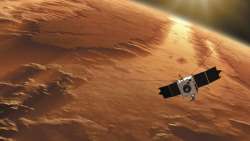Large solar storm sparks global aurora on Mars; doubles radiation levels on Martian surface
A strong solar storm hit Mars last month, sparking a global aurora at the Martian surface and causing the radiation level to double.

An unexpectedly strong solar storm hit Mars last month, sparking a global aurora at the Martian surface and causing the radiation level to double than highest ever recorded on the red planet, NASA scientists have found.
The solar event on September 11, 2017 sparked a global aurora at Mars more than 25 times brighter than any previously seen by the Mars Atmosphere and Volatile EvolutioN (MAVEN) orbiter, which has been studying the Martian atmosphere's interaction with the solar wind since 2014. MAVEN Mission is a space probe developed by NASA designed to study the Martian atmosphere while orbiting Mars.
The orbiter also recorded radiation levels on the surface more than double any previously measured by the Curiosity rover's Radiation Assessment Detector (RAD), since that mission's landing in 2012.
The high readings lasted more than two days, NASA found.
“NASA’s distributed set of science missions is in the right place to detect activity on the Sun and examine the effects of such solar events at Mars as never possible before,” said Elsayed Talaat, programme scientist at space agency headquarters in Washington.
Scientists found it strange as it occurred in conjunction with a spate of solar activity during what is usually a quiet period in the Sun’s 11-year sunspot and storm-activity cycle. This event was big enough to be detected at Earth too, even though Earth was on the opposite side of the Sun from Mars.
"The current solar cycle has been an odd one, with less activity than usual during the peak, and now we have this large event as we're approaching solar minimum," said Sonal Jain of the University of Colorado Boulder, who is a member of MAVEN's Imaging Ultraviolet Spectrograph instrument team.
"When a solar storm hits the Martian atmosphere, it can trigger auroras that light up the whole planet in ultraviolet light. The recent one lit up Mars like a light bulb," Jain said. "An aurora on Mars can envelope the entire planet because Mars has no strong magnetic field like Earth's to concentrate the aurora near polar regions. The energetic particles from the Sun also can be absorbed by the upper atmosphere, increasing its temperature and causing it to swell up."
Don Hassler, RAD Principal Investigator, said, "This is exactly the type of event both missions were designed to study, and it's the biggest we've seen on the surface so far."
“It will improve our understanding of how such solar events affect the Martian environment, from the top of the atmosphere all the way down to the surface,” Hassler said.
The Sun always emits a continuous stream of charged particles, mainly electrons and protons. Occasionally, eruptions called coronal mass ejections occur, with higher density, energy and speed of the ejected particles. These events vary in strength.
RAD monitored radiation levels inside the encapsulated spacecraft that carried Curiosity from Earth to Mars in 2011 and 2012 and has been steadily monitoring the radiation environment at Mars’ surface for more than five years.
“If you were outdoors on a Mars walk and learned that an event like this was imminent, you would definitely want to take shelter, just as you would if you were on a space walk outside the International Space Station,” Hassler said.
“To protect our astronauts on Mars in the future, we need to continue to provide this type of space weather monitoring there,” he said.